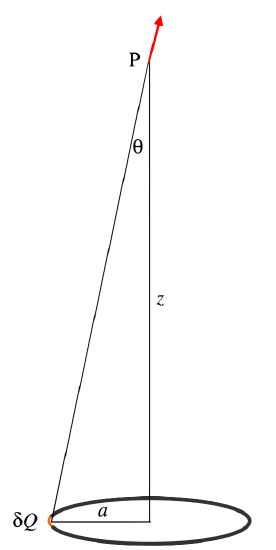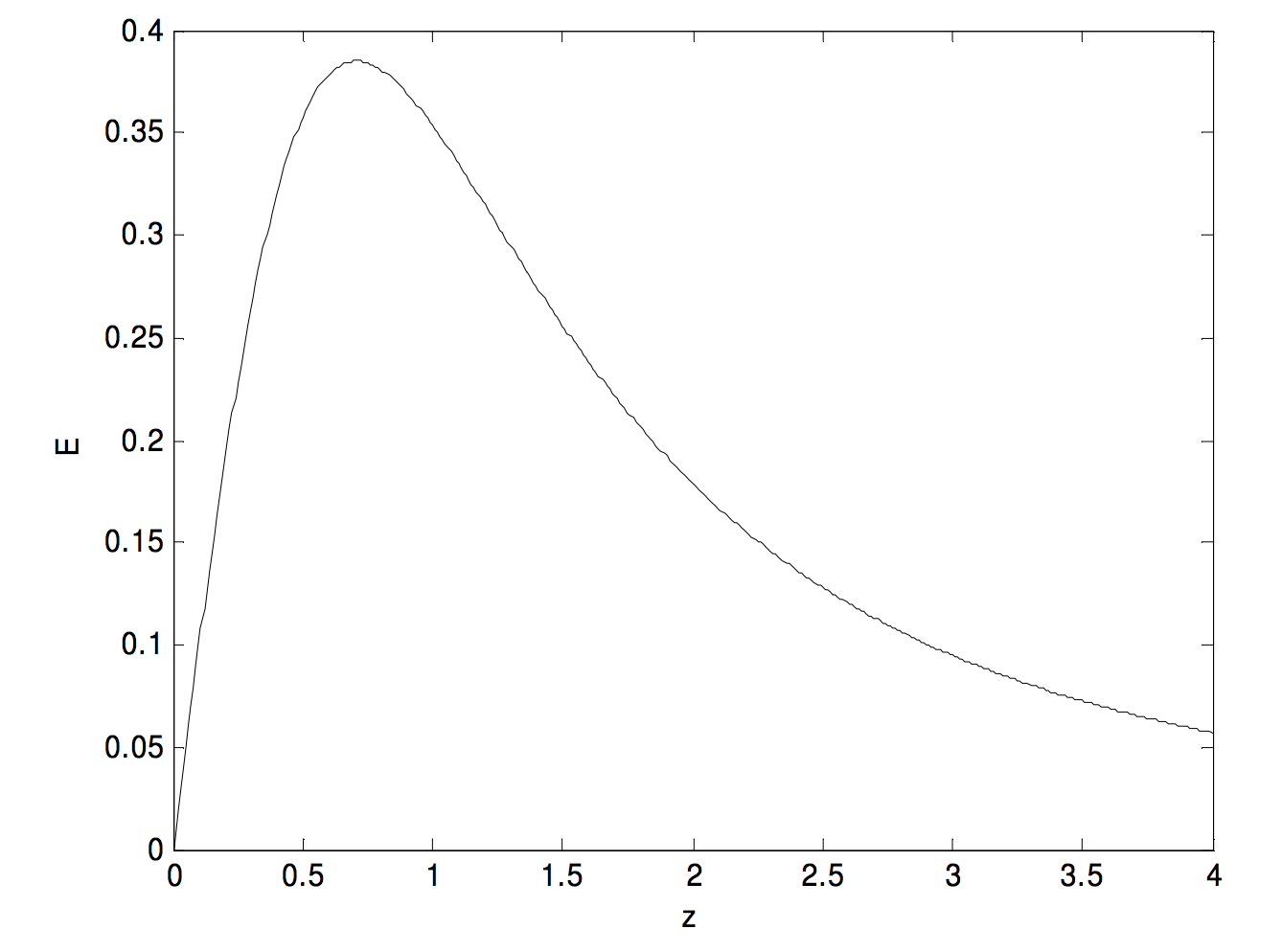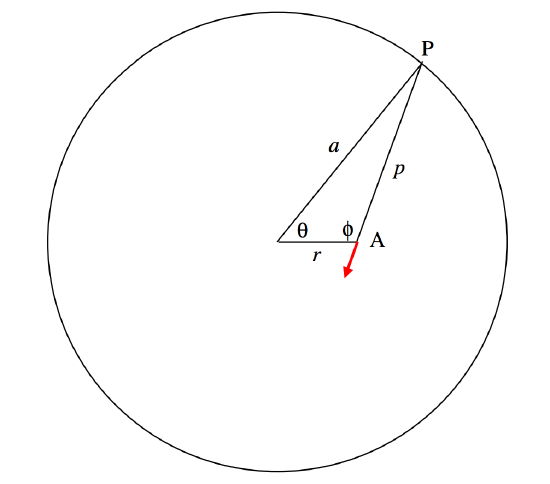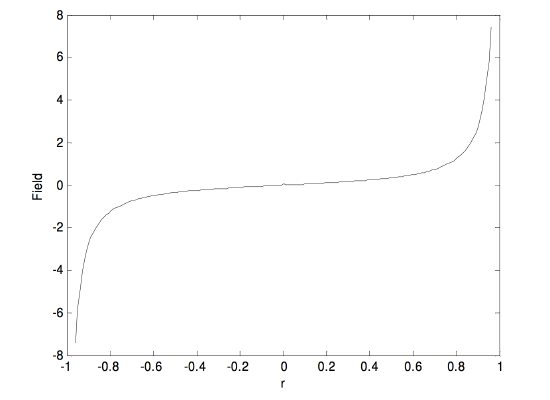1.6D: Field on the Axis of and in the Plane of a Charged Ring
- Page ID
- 6475
\( \newcommand{\vecs}[1]{\overset { \scriptstyle \rightharpoonup} {\mathbf{#1}} } \)
\( \newcommand{\vecd}[1]{\overset{-\!-\!\rightharpoonup}{\vphantom{a}\smash {#1}}} \)
\( \newcommand{\id}{\mathrm{id}}\) \( \newcommand{\Span}{\mathrm{span}}\)
( \newcommand{\kernel}{\mathrm{null}\,}\) \( \newcommand{\range}{\mathrm{range}\,}\)
\( \newcommand{\RealPart}{\mathrm{Re}}\) \( \newcommand{\ImaginaryPart}{\mathrm{Im}}\)
\( \newcommand{\Argument}{\mathrm{Arg}}\) \( \newcommand{\norm}[1]{\| #1 \|}\)
\( \newcommand{\inner}[2]{\langle #1, #2 \rangle}\)
\( \newcommand{\Span}{\mathrm{span}}\)
\( \newcommand{\id}{\mathrm{id}}\)
\( \newcommand{\Span}{\mathrm{span}}\)
\( \newcommand{\kernel}{\mathrm{null}\,}\)
\( \newcommand{\range}{\mathrm{range}\,}\)
\( \newcommand{\RealPart}{\mathrm{Re}}\)
\( \newcommand{\ImaginaryPart}{\mathrm{Im}}\)
\( \newcommand{\Argument}{\mathrm{Arg}}\)
\( \newcommand{\norm}[1]{\| #1 \|}\)
\( \newcommand{\inner}[2]{\langle #1, #2 \rangle}\)
\( \newcommand{\Span}{\mathrm{span}}\) \( \newcommand{\AA}{\unicode[.8,0]{x212B}}\)
\( \newcommand{\vectorA}[1]{\vec{#1}} % arrow\)
\( \newcommand{\vectorAt}[1]{\vec{\text{#1}}} % arrow\)
\( \newcommand{\vectorB}[1]{\overset { \scriptstyle \rightharpoonup} {\mathbf{#1}} } \)
\( \newcommand{\vectorC}[1]{\textbf{#1}} \)
\( \newcommand{\vectorD}[1]{\overrightarrow{#1}} \)
\( \newcommand{\vectorDt}[1]{\overrightarrow{\text{#1}}} \)
\( \newcommand{\vectE}[1]{\overset{-\!-\!\rightharpoonup}{\vphantom{a}\smash{\mathbf {#1}}}} \)
\( \newcommand{\vecs}[1]{\overset { \scriptstyle \rightharpoonup} {\mathbf{#1}} } \)
\( \newcommand{\vecd}[1]{\overset{-\!-\!\rightharpoonup}{\vphantom{a}\smash {#1}}} \)
\(\newcommand{\avec}{\mathbf a}\) \(\newcommand{\bvec}{\mathbf b}\) \(\newcommand{\cvec}{\mathbf c}\) \(\newcommand{\dvec}{\mathbf d}\) \(\newcommand{\dtil}{\widetilde{\mathbf d}}\) \(\newcommand{\evec}{\mathbf e}\) \(\newcommand{\fvec}{\mathbf f}\) \(\newcommand{\nvec}{\mathbf n}\) \(\newcommand{\pvec}{\mathbf p}\) \(\newcommand{\qvec}{\mathbf q}\) \(\newcommand{\svec}{\mathbf s}\) \(\newcommand{\tvec}{\mathbf t}\) \(\newcommand{\uvec}{\mathbf u}\) \(\newcommand{\vvec}{\mathbf v}\) \(\newcommand{\wvec}{\mathbf w}\) \(\newcommand{\xvec}{\mathbf x}\) \(\newcommand{\yvec}{\mathbf y}\) \(\newcommand{\zvec}{\mathbf z}\) \(\newcommand{\rvec}{\mathbf r}\) \(\newcommand{\mvec}{\mathbf m}\) \(\newcommand{\zerovec}{\mathbf 0}\) \(\newcommand{\onevec}{\mathbf 1}\) \(\newcommand{\real}{\mathbb R}\) \(\newcommand{\twovec}[2]{\left[\begin{array}{r}#1 \\ #2 \end{array}\right]}\) \(\newcommand{\ctwovec}[2]{\left[\begin{array}{c}#1 \\ #2 \end{array}\right]}\) \(\newcommand{\threevec}[3]{\left[\begin{array}{r}#1 \\ #2 \\ #3 \end{array}\right]}\) \(\newcommand{\cthreevec}[3]{\left[\begin{array}{c}#1 \\ #2 \\ #3 \end{array}\right]}\) \(\newcommand{\fourvec}[4]{\left[\begin{array}{r}#1 \\ #2 \\ #3 \\ #4 \end{array}\right]}\) \(\newcommand{\cfourvec}[4]{\left[\begin{array}{c}#1 \\ #2 \\ #3 \\ #4 \end{array}\right]}\) \(\newcommand{\fivevec}[5]{\left[\begin{array}{r}#1 \\ #2 \\ #3 \\ #4 \\ #5 \\ \end{array}\right]}\) \(\newcommand{\cfivevec}[5]{\left[\begin{array}{c}#1 \\ #2 \\ #3 \\ #4 \\ #5 \\ \end{array}\right]}\) \(\newcommand{\mattwo}[4]{\left[\begin{array}{rr}#1 \amp #2 \\ #3 \amp #4 \\ \end{array}\right]}\) \(\newcommand{\laspan}[1]{\text{Span}\{#1\}}\) \(\newcommand{\bcal}{\cal B}\) \(\newcommand{\ccal}{\cal C}\) \(\newcommand{\scal}{\cal S}\) \(\newcommand{\wcal}{\cal W}\) \(\newcommand{\ecal}{\cal E}\) \(\newcommand{\coords}[2]{\left\{#1\right\}_{#2}}\) \(\newcommand{\gray}[1]{\color{gray}{#1}}\) \(\newcommand{\lgray}[1]{\color{lightgray}{#1}}\) \(\newcommand{\rank}{\operatorname{rank}}\) \(\newcommand{\row}{\text{Row}}\) \(\newcommand{\col}{\text{Col}}\) \(\renewcommand{\row}{\text{Row}}\) \(\newcommand{\nul}{\text{Nul}}\) \(\newcommand{\var}{\text{Var}}\) \(\newcommand{\corr}{\text{corr}}\) \(\newcommand{\len}[1]{\left|#1\right|}\) \(\newcommand{\bbar}{\overline{\bvec}}\) \(\newcommand{\bhat}{\widehat{\bvec}}\) \(\newcommand{\bperp}{\bvec^\perp}\) \(\newcommand{\xhat}{\widehat{\xvec}}\) \(\newcommand{\vhat}{\widehat{\vvec}}\) \(\newcommand{\uhat}{\widehat{\uvec}}\) \(\newcommand{\what}{\widehat{\wvec}}\) \(\newcommand{\Sighat}{\widehat{\Sigma}}\) \(\newcommand{\lt}{<}\) \(\newcommand{\gt}{>}\) \(\newcommand{\amp}{&}\) \(\definecolor{fillinmathshade}{gray}{0.9}\)Field on the axis of a charged ring.

Ring, radius \(a\), charge \(Q\). Field at P from element of charge \(δQ = \dfrac{\delta Q}{4\pi\epsilon_0 (a^2+z^2)}\). Vertical component of this \(= \dfrac{\delta Q \cos \theta}{4\pi\epsilon_0 (a^2+z^2)}=\dfrac{\delta Qz}{4\pi\epsilon_0 (a^2+z^2)^{3/2}}\). Integrate for entire ring:
Field \(E = \dfrac{Q}{4\pi\epsilon_0}\dfrac{z}{(a^2+z^2)^{3/2}}\).
In terms of dimensionless variables:
\[E=\dfrac{z}{(1+z^2)^{3/2}}.\]
where E is in units of \(\dfrac{Q}{4\pi\epsilon_0 a^2}\), and \(z\) is in units of \(a\).

From calculus, we find that this reaches a maximum value of \(\dfrac{2\sqrt{3}}{9}=0.3849\) at \(z=1/\sqrt{2}=0.7071\).
It reaches half of its maximum value where \(\dfrac{z}{(1+z^2)^{3/2}}=\dfrac{\sqrt{3}}{9}\).
That is, \(3-72Z+9Z^2+3Z^2=0\), where \(Z=z^2\).
The two positive solution are \(Z = 0.041889 \text{ and }3.596267\).
That is, \(z = 0.2047 \text{ and }1.8964\).
Field in the plane of a charged ring.
We suppose that we have a ring of radius \(a\) bearing a charge \(Q\). We shall try to find the field at a point in the plane of the ring and at a distance \(r (0 ≤ r < a)\) from the centre of the ring.

Consider an element \(δθ\) of the ring at P. The charge on it is \(\dfrac{Q\delta \theta}{2\pi}\). The field at A from this element of charge is
\[\dfrac{1}{4\pi\epsilon_0}\cdot \dfrac{Q\delta\theta}{2\pi}\cdot \dfrac{1}{a^2+r^2-2ar\cos \theta}=\dfrac{Q}{4\pi\epsilon_0 .2\pi a^2}\cdot \dfrac{\delta\theta}{b-c\cos \theta},\]
where \(b=1+r^2/a^2\) and \(c = 2r / a\). The component of this toward the centre is
\(-\dfrac{Q}{4\pi\epsilon_0 .2 \pi a^2}\cdot\dfrac{\cos \phi \delta\theta}{b-c\cos \theta}\).
To find the field at A due to the entire ring, we must express \(\phi\) in terms of \(θ\), \(r \) and \(a\), and integrate with respect to \(θ \text{ from }0 \text{ to }2π\) (or from \(0 \text{ to }π\) and double it). The necessary relations are
\[p^2=a^2+r^2-2ar\cos \theta\]
\[\cos \phi = \dfrac{r^2+p^2-a^2}{2rp}.\]
The result of the numerical integration is shown below, in which the field is expressed in units of \(Q/(4\pi\epsilon_0 a^2)\) and \(r\) is in units of \(a\).



